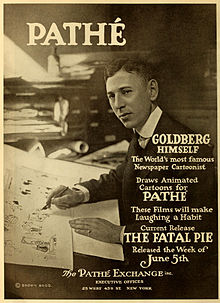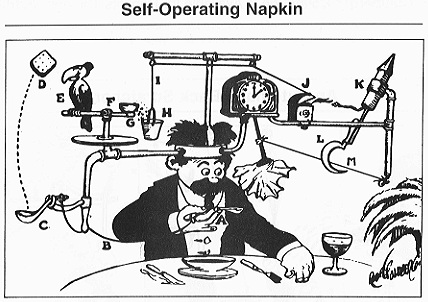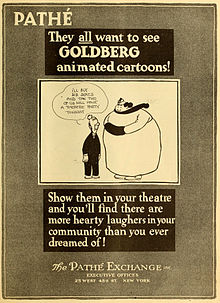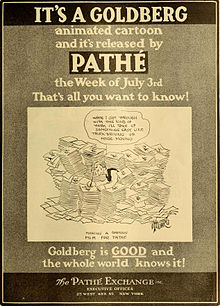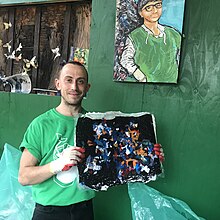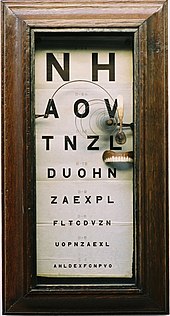A deathtrap is a literary and dramatic plot device in which a villain who has captured the hero or another sympathetic character attempts to use an elaborate, improbable, and usually sadistic method of murdering them.
It is often used as a means to create dramatic tension in the story and to have the villain reveal important information to the hero, confident that the hero will shortly not be able to use it. It may also be a means to show the hero's resourcefulness in escaping, or the writer's ingenuity at devising a last-minute rescue or deus ex machina.
It is often used as a means to create dramatic tension in the story and to have the villain reveal important information to the hero, confident that the hero will shortly not be able to use it. It may also be a means to show the hero's resourcefulness in escaping, or the writer's ingenuity at devising a last-minute rescue or deus ex machina.
History
This plot device is generally believed to have been popularized by movie serials and 19th-century theatrical melodramas. A well-known example is the cliché of the moustache-twirling villain leaving the heroine tied to railroad tracks. Its use in the James Bond film series and superhero stories is well known.
Narrative use
It
is a common criticism that it is unbelievable in story plots to have
villains try to kill the heroes in such elaborate ways when they could
use simple methods like shooting them. Throughout the decades, comic book writers have responded to these complaints by devising ways in which the deathtraps have served other purposes.
For instance, one Legion of Super-Heroes story by Jim Shooter had a team of Legionnaires put into a variety of deathtraps and the villains wanted
the heroes to successfully escape. This was because the real purpose of
the deathtraps was to have the Legionnaires use a great deal of energy
doing so, which the villains then harnessed for their own benefit. Other
stories have had villains use deathtraps as a means of testing the
heroes or to distract them while the villain attends to other matters.
On some occasions, the deathtrap is a machine that "absorbs" the energy
from the hero/heroes.
Another rationalization for a deathtrap is when a particular
villain simply enjoys leaving his victims some small chance of survival,
just for the sake of sport. Such "sporting" villains include the Riddler, who has an uncontrollable compulsion to create intellectual challenges for his enemies. Also included in this list is the Jigsaw Killer, who places his victims in life-or-death situations to prove that they appreciate life. The Joker and Arcade are other villains who simply enjoy the challenge.
On occasion, the villain may employ a slow deathtrap because they
enjoy their victim's suffering prior to death, either due to sadistic
tendencies or a desire for painful vengeance.
In a similar vein, the villain, often a megalomaniac,
may feel that, as a reflection of his own imagined greatness, it would
be "beneath him" to murder his enemy like any common criminal, and that
his enemy's death should be the worthy spectacle that a successful
deathtrap would provide. In contrast, he may feel that his enemy, having
provided him with a worthy challenge in their earlier encounters,
himself "deserves" such a grandiose death, or that the enmity between
the two is so "epic" that it merits no less than such a conclusion.
Conversely, the protagonists' act of falling into such a trap may
itself be the reason they are written off and left unattended. The
villain, disappointed in such a non-threatening opponent, loses
interest, and intentionally leaves some chance of escape for the
protagonists to "redeem" themselves. However, the disillusioned villain
tends to assume that the chance is minuscule. Despite secretly hoping
that the opponent survives and proves worthy of interest, the now-bored
villain is invariably shocked when that actually occurs.
If fully serious, the villain may simply be too insane to
recognize the impracticality of the situation, although this
characterization is rarely seen outside of deliberately parodic
characters such as Dr. Evil.
A more recent reason is villains do it simply because it is
considered 'tradition' or 'rule' of being a supervillain to place a hero
in a deathtrap and then leave them to their fate. This even goes as far
as heroes, or other villains, insulting a villain for attempting to
avoid using a deathtrap or staying to watch. El Sombrero is one villain who exemplifies this reason.
When a hero's sidekick or loved one is placed in a deathtrap, its
purpose is often to distract the hero, occupying time and attention
while the villain pursues their evil plan. Less frequently, the villain
intends to instill grief and guilt as a means of defeating a hero that
cannot be defeated physically. Multiple secondary characters may be
placed in deathtraps to offer the hero an agonizing choice, ostensibly
forcing the hero to save one victim and leave the other(s) to die.
Famous examples
- The Engineer's Thumb (Sherlock Holmes story): the engineer Victor Hatherley is trapped inside a hydraulic press which would crush him to a pulp
- Escape method: a woman working for the villains but not sharing their criminal ruthlessness opens a side panel at the last moment, allowing Hatherley to escape
- Raiders of the Lost Ark: Sealing Indiana Jones and Marion in the Well of Souls
- Escape method: Seeing a possible tunnel entrance, Jones climbed a statue and toppled it towards the wall to create an entrance to a passageway that led to the outside.
- Live and Let Die:
Doctor Kananga and a minion tie James Bond and Solitaire to a platform
to be lowered into a shark-infested pool to be eaten alive.
- Escape method: Without the villains seeing, Bond activates his watch's rotary saw function to cut through his restraints to free himself and attack Kananga.
- Goldfinger: James Bond is shackled spreadeagled to a table and a circular saw (a laser in the film)
is approaching to cut him in half. Unlike many deathtrap scenarios,
Bond remains under constant supervision, and he does not use (or have) a
device or outside help to escape.
- Escape method: Bond bluffs Goldfinger, and persuades him that his replacement "008" also knows about Goldfinger's plans and that Bond's death will immediately summon him to investigate, so Goldfinger elects to not take the chance of another spy coming on the scene to interfere, which he can avoid by holding Bond captive.
- Edgar Allan Poe's "The Pit and the Pendulum":
The unnamed character finds himself bound to a large slab, beneath a
bladed pendulum that slowly lowers toward him as it swings, with the
intention of slicing through his chest.
- Escape method: The character lures mice to the ropes with a piece of meat. They chew through the ropes, allowing him to escape before the pendulum can slice him open.
- In the Dudley Do-Right cartoon, villain Snidely Whiplash (a parody of the stereotypical "movie-serial" villain) tied up Nell Fenwick on a table-saw conveyor belt. The narrator (Paul Frees) noted that, "Fortunately, the belt was in need of oiling, so the trip was a slow one." In elapsed time, through the course of the story, this actually took several hours.
- The 1960s live action television series Batman usually had two-part episodes use a bizarre deathtrap as a cliffhanger.
- Example: The Joker
traps the Dynamic Duo without their utility belts in the bottom of an
industrial smokestack and begins to gradually fill it with a deadly
heavier-than-air gas.
- Escape method: The pair lock elbows and brace their backs against each other to walk up the smokestack to the top opening and slide down a support cable safely to the ground.
- Example: The Joker
traps the Dynamic Duo without their utility belts in the bottom of an
industrial smokestack and begins to gradually fill it with a deadly
heavier-than-air gas.
- The Venture Brothers:
Doctor Venture in Escape to the House of Mummies Part 2. He described
the trap he was in as "Slower than haunted house spiked walls, but not
quite as slow as evil scientist spiked walls."
- Escape Method: Magic forcing the walls to stop. A secondary, previously unknown Boiling Oil trap failed when a henchman confused it for "Hot Voile", which was being warmed in a clothes dryer.
- The Perils of Penelope Pitstop always involved improbable deathtraps, usually set by the Hooded Claw.
- Disney's The Great Mouse Detective:
Ratigan ties up Basil and Dawson in an intricate mousetrap and tells
them about his plot to kill the queen. He then leaves to see his scheme
unfold, assuming that they will soon be dead.
- Escape method: Basil activates the mousetrap he and Dawson are trapped in early, catching the ball that was meant to crush them, and setting off a chain reaction that interferes with every other aspect of the trap.
- Saw: The plot of the series revolves around the Jigsaw Killer, a terminally ill vigilante who kidnaps his victims and places them in deadly traps, both to test them and to give them an opportunity to repent for former lifestyles in which they took their lives for granted and were unappreciative and unconcerned with the well-being of others.
- The Snowman: Rakel, Harry Hole's
beloved, is forced to sit on a fast-melting snowman; when it had melted
she would fall down and the razor-sharp wire around her neck would
decapitate her.
- Escape Method: Harry arrives on the scene and extricates Rakel in nick of time, at the acceptable price of the wire cutting off one of his fingers.
- Titanic (1997 film): Jack Dawson is chained in a room deep down inside the ship, where he is meant to disappear and be conveniently drowned as the ship sinks, but is rescued by his lover Rose. The entire second half of the film can also be seen as an extended deathtrap situation, where the thousands of people on board find themselves faced with a painful and absurd death, due to their having bought tickets or enlisted as crew on the glamorous ship, the epitome of technical progress and luxury, and now have to either reach the lifeboats and escape or else accept their death. The villain here, in a sense, is the ship and its careless masters.
- Final Destination: The plot of the series revolves around several people surviving a catastrophe because one of them had a premonition of it. In doing this the survivors have cheated Death, a malevolent and unseen force that sets up deathtraps to kill off the survivors in the order in which they had originally died.
A simpler variation on the deathtrap is the villain speech, also known as monologuing.
The villain, after having captured the hero or another victim, gives a
long speech taunting and sneering at his victim, pontificating on how
said victim will soon die, and reminiscing over how he tried for so long
to get his kill and is now about to reap the reward. Villains may also
give away details of their evil plots, on the rationale that the victim
will die immediately and the villain often believes their victim
deserves to know. This speech, given when the villain could have just
killed the victim in a matter of seconds, is invariably used to give
another character time to come in and save the victim, or for the victim
to escape. In The Incredibles (which used the term "monologuing"), Mr. Incredible and Frozone attacked villains in the middle of their speeches (Mr. Incredible is seen attacking Syndrome
and Frozone is mentioned to have attacked Baron von Ruthless
off-camera). In a literary sense, the villain speech is also used as a
form of exposition.
Even in relatively realistic stories, villains will often take a
moment to say something pithy before finishing off the victim. The
antagonist would often leave the victim to die whilst they commit their
evil scheme. This is echoed in the film 2001 - A Space Odyssey
when Hal the supercomputer, confident that Dave will soon perish
outside the ship, tells him that he is about to take control of the
expedition and then sees Dave off with the flat remark: "This
conversation can have no meaningful purpose anymore - goodbye!". Dave
manages to make his way inside and kill Hal.
Spoofs
The concept of the deathtrap/monologue is featured in many satires.
- Deathtraps were spoofed heavily in the Austin Powers movies, including a replication of James Bond's Shark Infested Water deathtrap. It is first introduced as "an easily escapeable situation involving an overly elaborate and exotic death" with Austin placed on a platform over a pool (which Dr. Evil calls "the unnecessarily slow-moving dipping mechanism"). The trap is escaped by swinging on a grapple of dental floss. As the intended sharks with laserbeams were unavailable due to the complexities of international law regarding endangered species (much to Dr. Evil's disappointment), ill-tempered mutant seabass are used instead. As part of the spoof, Scott Evil, Dr. Evil's son, insists that the deathtrap is pointless and that they could simply shoot them with a pistol, which is nearby, and yells at his father for the further incompetence of leaving them alone. Dr Evil responds that not watching the killing but assuming it went well makes perfect sense.
- In the sitcom Blackadder, Prince Edmund is captured by his nemesis, the Hawk, who straps him into a chair which, in sixty seconds, will mutilate him in a variety of ways. Edmund's friends, Baldrick and Percy, manage to poison the Hawk and his followers, but while celebrating this unlikely victory, the time runs out, and Edmund suffers a terrible fate. In another episode, Lord Flashheart is confronted by a villain who begins an evil villain speech. However, rather than waiting for him to finish, Flashheart merely shoots him without warning.
- Curse of Monkey Island makes fun of this cliché. The villain LeChuck, after capturing Guybrush Threepwood, insists on telling him his plans before executing him. By this dialogue, interesting background story that connect the games together are given to the player. Guybrush does him the favour to listen, but after a while he is so bored that he refuses to listen any more, even if LeChuck pleads to continue.
- The famous line from Watchmen wherein the character Ozymandias takes his time and explains in detail how he will set his plan irrevocably in motion and then, in a deliberate skewering of the monologuing tendencies of supervillains, explains that "Dan, I'm not a Republic serial villain. I did it thirty-five minutes ago."
- In The Simpsons episode "You Only Move Twice", which generally spoofs Bond villain clichés, supervillain/great boss Hank Scorpio has "Mr. Bont" strapped to a table with a laser à la Goldfinger. Bont manages to escape, only to be tackled by Homer. Scorpio's henchmen promptly shoot Bont.
- Some incarnations of the Evil Overlord List point out the impracticality of deathtraps. Some examples include making sure the deathtrap has a VERY small estimated time of death or such lines as "Shooting is NOT too good for my enemies."
- Season 5 Episode 8 of the animated classic series The Flintstones entitled "Dr. Sinister" spoofed the James Bond series ("James Bondrock") and featured, among other deathtraps, Fred and Barney being tied to a slab with a slowly descending pendulum with blade, a la Poe's "The Pit and the Pendulum". The duo escape when Barney holds his tied hands up and the blade slices through his bonds. He then unties himself and frees Fred before the final swing slices the slab in half.
